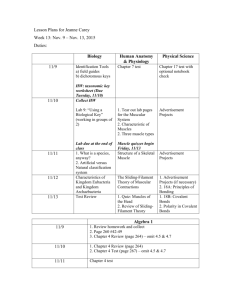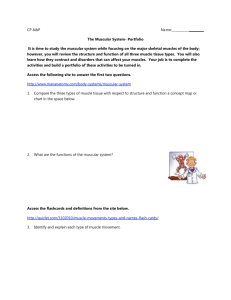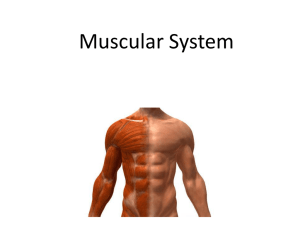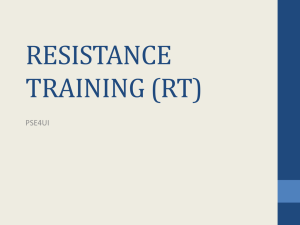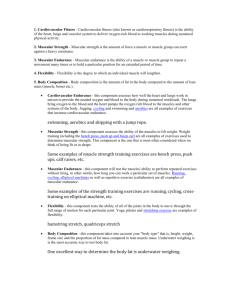The Muscular System
advertisement
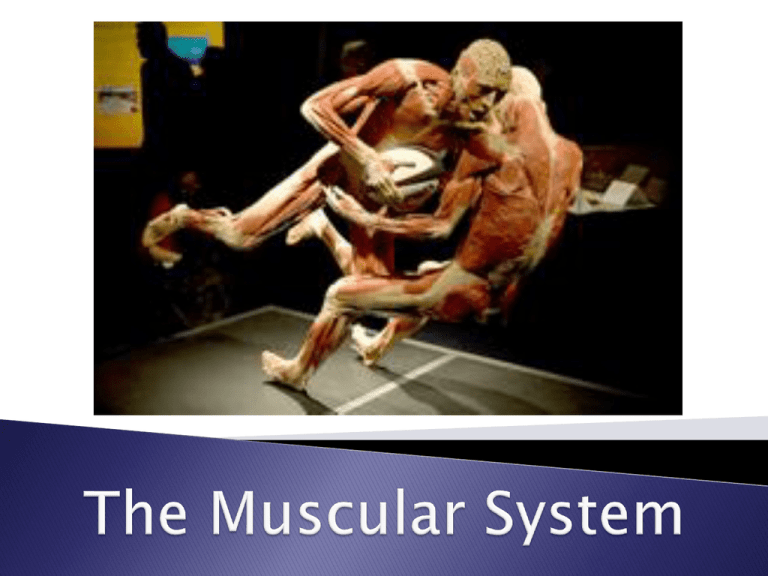
There are approximately 640 named skeletal muscles in the human body. ◦ There are also many more!! There are 11 major muscles that you will need to know about for your GCSE PE examination. 1. 6. 2. 3. 7. 8. 4. 9. 5. 10. 11. Front View Back View Deltoids Trapezius Pectorals Biceps Triceps Latissimus Dorsi Abdominals Gluteals Quadriceps Hamstrings Gastrocnemius Front View Back View By the end of this lesson you should be able to: Identify the major muscle groups Explain the role of muscles in movement. Explain the immediate effects of exercise on the muscular system. Explain the long term benefits of exercise on the muscular system The main function of skeletal muscle is to produce movement. Muscles are attached to the skeleton, so that they can contract and pull on bones ◦ Muscles are attached to bones by tendons. Muscles are attached at both ends ◦ One end is called the origin and is fixed to something rigid. ◦ The other end – the insertion – is attached to the bone that moves. Muscles are arranged in antagonistic pairs, so when one muscle contracts and pulls the other relaxes to allow the joint to work. The muscle that contracts is the agonist. The muscle that is relaxed is called the antagonist. The Muscular System works in antagonistic pairs to produce movement at joints There are 5 different types of movement that can be produced: 1. Flexion Some joints can 2. Extension produce more 3. Abduction types of 4. Adduction movement than 5. Rotation others. Increased muscle size: Hypertrophy Training using the principle of progressive overload, applies stress to the skeletal muscles. This results in them being damaged as the muscle fibres are pulled apart causing trauma. The body rebuilds bridges between muscle fibres, and actually makes them slightly stronger This requires up to 48 hours. Complete your movement analysis worksheet ◦ The immediate effects of exercise on the muscular system (pg 143-44) ◦ Key words: Isometric & Isotonic contractions Oxygen Lactic Acid OR ◦ The Long term benefits of exercise on the Muscular system & potential injuries to the muscular system(144145) ◦ Key words: Hypertrophy Posture Soft tissue injuries Exercise increases the body’s demand for Oxygen and glycogen as the muscles need more fuel to function. Extra waste products are created, and extra blood needs to be pumped around the body to take these away. Aerobic exercise can continue for a sustained period of time as the intensity is relatively low. High intensity exercise will result in the production of lactic acid, if this builds up then exercise will cease as muscles begin to ache and possibly cramp By the end of this lesson you should be able to: Identify the major muscle groups Explain the role of muscles in movement. Explain the immediate effects of exercise on the muscular system. Explain the long term benefits of exercise on the muscular system

